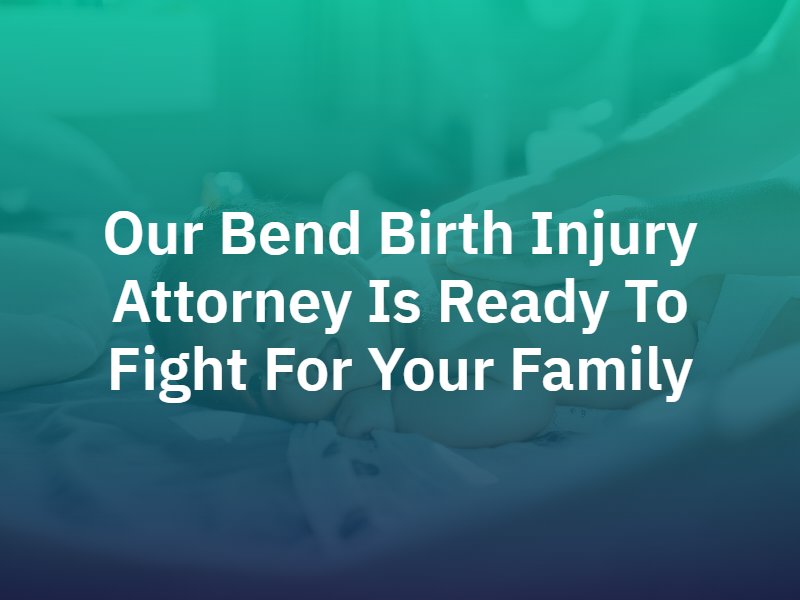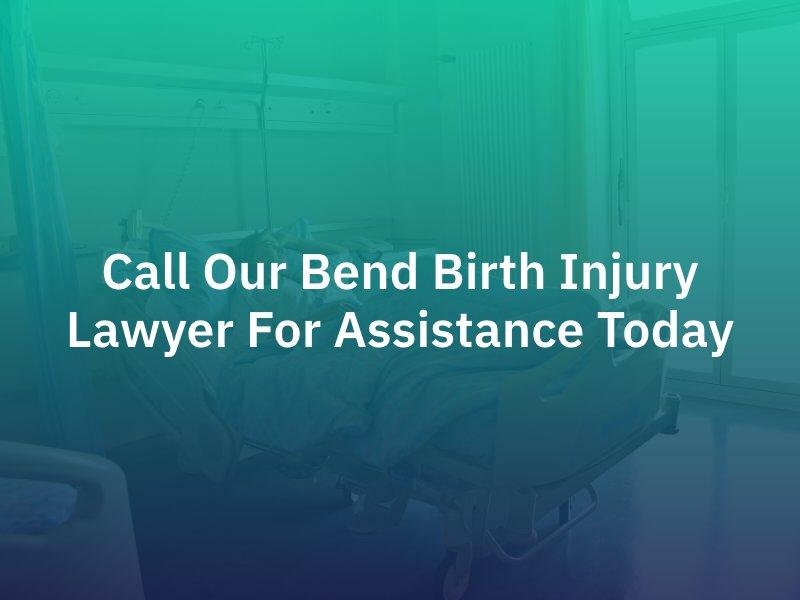Bend Birth Injury Lawyer
It is devastating for a family when a child is seriously injured at birth. Our experienced Bend personal injury attorneys at Paulson Coletti Trial Attorneys PC are tough advocates for birth injury victims. We can investigate the cause of the injury and get justice for your child. Contact us as soon as possible to schedule a consultation if you believe your child suffered birth injuries through medical negligence.
Bend Birth Injury Resources
To immediately access the resources at any point on this page, click the corresponding links below.
Why Choose Us?
Most Common Causes of Birth Injuries
Types of Birth Injuries
Who Is Liable for Birth Injuries?
Why You Need an Attorney
Time Limits on Oregon Birth Injury Cases
Speak to a Lawyer Today
Why Choose Us?
- At Paulson Coletti Trial Attorneys PC, we believe that “liberty and justice for all” is more than just a phrase. We are aggressive negotiators and experienced trial lawyers who will not hesitate to fight in court for the maximum compensation under the law.
- Our medical malpractice attorneys in Bend have an excellent reputation, numerous recognitions, and awards from respected organizations, and more than a century of combined experience.
- We maintain a smaller caseload so we can give your case the personal attention it deserves.

Most Common Causes of Birth Injuries in Bend
Birth injuries in Bend can occur in a variety of ways. Some of the most common of these birth injury causes include the following:
- Prolonged or Difficult Labor. Prolonged labor, also known as dystocia, can increase the risk of birth injuries. It may lead to oxygen deprivation, fetal distress, or the need for interventions such as forceps or vacuum extraction, which can contribute to injuries like brachial plexus injuries.
- Improper or Excessive Use of Medical Interventions. Improper or excessive use of medical interventions during childbirth can contribute to birth injuries. Examples include the improper use of forceps or vacuum extraction, inappropriate administration of labor-inducing medications, or unnecessary episiotomies.
- Failure to Monitor Fetal Distress. Continuous monitoring of the baby’s heart rate during labor is crucial to detect signs of fetal distress. Failure to recognize and respond promptly to fetal distress can result in oxygen deprivation and other complications leading to birth injuries.
- Delayed or Inadequate C-Section. In some cases, a cesarean section (C-section) is necessary to ensure the safety of the baby and mother. Delayed or inadequate decision-making regarding a C-section when medically indicated can contribute to birth injuries.
- Negligence or Medical Malpractice. Negligence or medical malpractice by healthcare professionals, such as failure to follow standard protocols, improper use of medical equipment, or insufficient monitoring, can increase the risk of birth injuries.
- Fetal Positioning. The position of the baby during delivery can influence the risk of birth injuries. For example, if the baby is in a breech birth position (feet or buttocks first) or in an abnormal presentation, there is an increased risk of complications and potential birth injuries.
- Size Discrepancy. When there is a major difference in size between the baby and the mother’s pelvis, it can lead to difficulties during delivery. This size discrepancy may result in prolonged labor, the need for instrumental delivery, or the risk of shoulder dystocia, potentially leading to birth injuries.
It is important to note that many of the items on the list above may seem like something that is unavoidable, particularly prolonged labor and delivery, fetal positioning, and size discrepancy. However, medical professionals involved with labor and delivery should always monitor hey mother and child and determine the best steps to take to prevent fetal or maternal distress or injury. This includes opting for a C-section or taking other medical interventions to prevent serious harm if these issues arise.
Types of Birth Injuries
- Brachial Plexus Injuries – Brachial plexus injuries involve damage to the network of nerves that control movement and sensation in the arms and hands. This can occur when the baby’s shoulder gets stuck during delivery (shoulder dystocia) or through excessive stretching or pulling of the baby’s head and neck during a difficult delivery.
- Cerebral Palsy – Cerebral palsy is a neurological disorder. This disorder is primarily caused by brain damage or abnormal brain development before, during, or shortly after birth. It can result in difficulties with muscle control, coordination, movement, and other neurological functions.
- Facial Nerve Injuries – Facial nerve injuries can occur during birth due to pressure or trauma to the baby’s face. It may lead to temporary or permanent facial paralysis or weakness.
- Fractures – Fractures, such as collarbone fractures, can happen during difficult or complicated deliveries, particularly if the baby’s shoulder gets stuck in the birth canal.
- Perinatal Asphyxia – Perinatal asphyxia refers to inadequate oxygen supply to the baby’s brain before, during, or after birth. It can lead to long-term neurological damage or developmental disabilities if not promptly treated.
- Intracranial Hemorrhage – Intracranial hemorrhage refers to bleeding inside the baby’s skull. It can occur due to trauma during delivery or other factors, and the severity can range from mild to severe.
- Spinal Cord Injuries – Spinal cord injuries during birth can result from trauma or excessive force applied to the baby’s spine. The severity of these injuries can vary, leading to varying degrees of motor and sensory impairment.
- Perinatal Infections – Infections acquired during pregnancy or at the time of birth can have a detrimental impact on the baby’s health. Conditions like neonatal sepsis or meningitis can cause serious complications and long-term health issues.
It is important to remember that every birth injury case is unique, and the specific circumstances and severity of the injury can vary. Proper medical evaluation and diagnosis are necessary to determine the type and extent of a birth injury. If you think a birth injury has occurred, it is crucial to consult with medical professionals for accurate assessment, diagnosis, and appropriate treatment.
Who Is Liable for Birth Injuries in Bend?
Determining liability for a birth injury can be a complex process. This involves looking into the circumstances surrounding the injury and identifying the responsible parties. The following are some potential liable parties and the reasons why they could be held accountable:
- Healthcare Professionals:
- Obstetricians: Obstetricians are responsible for the care and management of the pregnancy, labor, and delivery. These medical professionals can be held liable if their negligence, such as failure to monitor fetal distress or the improper use of medical instruments, leads to a birth injury.
- Nurses: Labor and delivery nurses play a crucial role in monitoring the mother and baby during childbirth. If they fail to identify and communicate signs of fetal distress, administer appropriate medications, or provide adequate postpartum care, they may be held liable.
- Anesthesiologists: If the mother requires anesthesia during childbirth, anesthesiologists are responsible for administering and monitoring its effects. Errors in dosage or administration can result in harm to the mother or the baby.
- Hospital or Healthcare Facility:
- Inadequate Staffing: Hospitals and healthcare facilities have a duty to ensure sufficient staffing levels to handle the demands of childbirth. If understaffing leads to delays in providing necessary care or monitoring, the facility may be held liable for resulting birth injuries.
- Inadequate Policies and Procedures: If a hospital fails to implement proper protocols and guidelines for childbirth, such as emergency response procedures or standards for fetal monitoring, and a birth injury occurs as a result, the hospital may be held responsible.
- Pharmaceutical Companies:
- Defective Drugs or Medications: If a birth injury occurs due to a defect in a drug or medication administered during pregnancy or labor, the pharmaceutical company that manufactured or distributed the product could be held liable for any injuries or illnesses that occur.
- Medical Equipment Manufacturers:
- Defective Medical Devices: If a birth injury is caused by a fault in a medical device or equipment used during labor or delivery, such as a forceps or vacuum extractor, the manufacturer of the device or equipment may be held liable for the injury.
- Other Potentially Liable Parties:
- Third-party Healthcare Providers: If a birth injury occurs due to the carelessness or negligence of a healthcare provider who is not a direct employee of the hospital or healthcare facility, such as a contracted specialist, that individual may be held responsible.
- Parents: In rare cases, if the parents fail to follow medical advice, ignore warnings, or engage in reckless behavior during pregnancy or childbirth that leads to a birth injury, they may be held partially liable.
Why Do You Need a Bend Birth Injury Lawyer?
Birth injury cases involve complex medical and legal issues and frequently require the testimony of expert witnesses. It is in your best interests to have an experienced birth injury attorney by your side to:
- Investigate your child’s injuries
- Consult with medical professionals
- Determine cause and liability
- Construct a compelling case based on the facts
- Negotiate aggressively on your behalf
- Fight for the compensation you deserve in court, if necessary
How Long do I Have to File a Birth Injury Claim in Oregon?
According to Oregon Revised Statutes section 12.110, the law states that most medical malpractice claims must be filed within two years from the date the injury or illness was first discovered or from when the injury or illness should have been discovered through the exercise of reasonable care. There is an overall timeline and place that states all medical malpractice actions must be filed within five years from the incident, regardless of when an individual knew about the harm.
However, there are various exceptions to the medical malpractice statute of limitations in Oregon. One of these exceptions deals with individuals who sustain injuries or illnesses and are under the age of 18. This would apply to birth injury claims. The statute of limitations clock can be paused (tolled) for up to five years from when the incident occurs or for one year after an individual turns 18, whichever comes first.
We encourage you to reach out to a skilled medical malpractice attorney with experience handling birth injuries. If you are a parent or if you are a minor who believes they have been harmed due to medical negligence, an attorney can guide you toward the best path for recovering compensation in your situation. At the very least, let an attorney give you a free consultation so you can understand your options.

Contact Us Today
At Paulson Coletti Trial Attorneys PC, we are committed to pursuing justice for seriously injured victims. If you believe your child suffered birth injuries caused by medical negligence, speak with our experienced birth injury lawyers right away.
